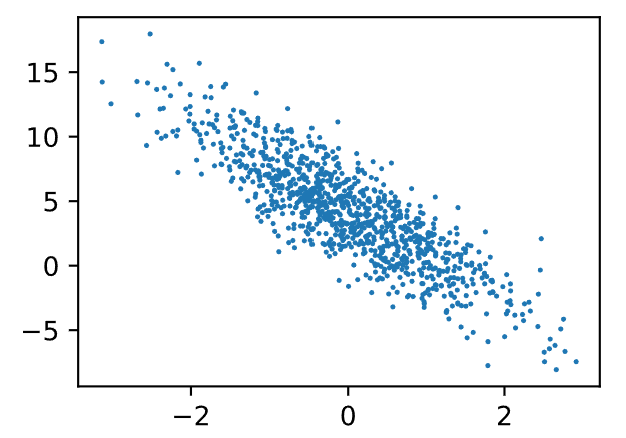# 生成数据
class SyntheticRegressionData(d2l.DataModule): #@save
"""Synthetic data for linear regression."""
def __init__(self, w, b, noise=0.01, num_train=1000, num_val=1000,
batch_size=32):
super().__init__()
self.save_hyperparameters()
n = num_train + num_val
self.X = torch.randn(n, len(w))
noise = torch.randn(n, 1) * noise
self.y = torch.matmul(self.X, w.reshape((-1, 1))) + b + noise
或者
1000 个样本,每个两个特征
$\mathbf{w} = [2, -3.4]^\top$、$b = 4.2$
$$\mathbf{y}= \mathbf{X} \mathbf{w} + b + \mathbf\epsilon.$$
def synthetic_data(w, b, num_examples): #@save
"""生成y=Xw+b+噪声"""
X = torch.normal(0, 1, (num_examples, len(w)))
y = torch.matmul(X, w) + b
y += torch.normal(0, 0.01, y.shape)
return X, y.reshape((-1, 1))
# 随便设一下超参数
true_w = torch.tensor([2, -3.4])
true_b = 4.2
features, labels = synthetic_data(true_w, true_b, 1000)
# 看下图像(分布)
d2l.set_figsize()
d2l.plt.scatter(features[:, 1].detach().numpy(), labels.detach().numpy(), 1);

def data_iter(batch_size, features, labels):
num_examples = len(features)
indices = list(range(num_examples))
# 这些样本是随机读取的,没有特定的顺序
random.shuffle(indices)
for i in range(0, num_examples, batch_size):
batch_indices = torch.tensor(
indices[i: min(i + batch_size, num_examples)])
yield features[batch_indices], labels[batch_indices]
## yield 在python中表示返回一个批次的特征和标签。每次调用 data_iter 时,它会生成一个新的批次,直到所有数据都被处理完。
batch_size = 10
#看一眼数据
for X, y in data_iter(batch_size, features, labels):
print(X, '\n', y)
break
w = torch.normal(0, 0.01, size=(2,1), requires_grad=True)
b = torch.zeros(1, requires_grad=True)
def linreg(X, w, b): #@save
"""线性回归模型"""
return torch.matmul(X, w) + b
def squared_loss(y_hat, y): #@save
"""均方损失"""
return (y_hat - y.reshape(y_hat.shape)) ** 2 / 2
# sgd优化算法
def sgd(params, lr, batch_size): #@save
"""小批量随机梯度下降"""
with torch.no_grad():
for param in params:
param -= lr * param.grad / batch_size
param.grad.zero_()
## torch.no_grad()表示 更新参数时不参与梯度计算
这个上下文中,所有涉及张量操作的梯度都不会被计算和存储。如果不加,那在更新参数时,PyTorch 会继续跟踪这些操作并计算梯度。造成浪费。
lr = 0.03
num_epochs = 3
net = linreg
loss = squared_loss
for epoch in range(num_epochs):
for X, y in data_iter(batch_size, features, labels):
l = loss(net(X, w, b), y) # X和y的小批量损失
# 因为l形状是(batch_size,1),而不是一个标量。l中的所有元素被加到一起,
# 并以此计算关于[w,b]的梯度
l.sum().backward()
sgd([w, b], lr, batch_size) # 使用参数的梯度更新参数
with torch.no_grad():
train_l = loss(net(features, w, b), labels)
print(f'epoch {epoch + 1}, loss {float(train_l.mean()):f}')
# epoch 1, loss 0.045634
# epoch 2, loss 0.000185
# epoch 3, loss 0.000052
print(f'w的估计误差: {true_w - w.reshape(true_w.shape)}')
print(f'b的估计误差: {true_b - b}')
w的估计误差: tensor([-0.0002, -0.0004], grad_fn=<SubBackward0>)
b的估计误差: tensor([0.0012], grad_fn=<RsubBackward1>)
2. Concise Pytorch简介实现
# torch.util里自带的Data的API (data.TensorDataset,Dataloader)
def load_array(data_arrays, batch_size, is_train=True): #@save
"""构造一个PyTorch数据迭代器"""
dataset = data.TensorDataset(*data_arrays)
return data.DataLoader(dataset, batch_size, shuffle=is_train)
batch_size = 10
data_iter = load_array((features, labels), batch_size)
next(iter(data_iter))
# nn是神经网络的缩写
from torch import nn
net = nn.Sequential(nn.Linear(2, 1))
# 初始化,XB填N(0,0.01)和0
net[0].weight.data.normal_(0, 0.01)
net[0].bias.data.fill_(0)
loss = nn.MSELoss()
trainer = torch.optim.SGD(net.parameters(), lr=0.03)
num_epochs = 3
for epoch in range(num_epochs):
for X, y in data_iter:
l = loss(net(X) ,y)
trainer.zero_grad()
l.backward()
trainer.step()
l = loss(net(features), labels)
print(f'epoch {epoch + 1}, loss {l:f}')
# epoch 1, loss 0.000103
# epoch 2, loss 0.000104
# epoch 3, loss 0.000103
w = net[0].weight.data
print('w的估计误差:', true_w - w.reshape(true_w.shape))
b = net[0].bias.data
print('b的估计误差:', true_b - b)
w的估计误差: tensor([1.6212e-05, 3.0875e-04])
b的估计误差: tensor([-0.0002])
with 是python上下文管理器,语法如下:
with expression as variable:
# 代码块
比如打开文件:
with open('example.txt', 'r') as file:
contents = file.read()
print(contents)
next(iterator[, default])
# 创建一个简单的迭代器
numbers = iter([1, 2, 3, 4, 5])
print(next(numbers)) # 输出 1
print(next(numbers)) # 输出 2
print(next(numbers)) # 输出 3
print(next(numbers)) # 输出 4
print(next(numbers)) # 输出 5
# 如果继续调用 next(numbers),会引发 StopIteration 异常
迭代器是一个实现了迭代协议的对象,具体来说,它实现了 __iter__() 和 __next__() 方法。
def simple_generator():
yield 1
yield 2
yield 3
gen = simple_generator()
print(next(gen)) # 输出 1
print(next(gen)) # 输出 2
print(next(gen)) # 输出 3

